Hedge Using Monte Carlo Simulation
This example shows how to use Monte Carlo simulation to model the probability of different outcomes in a process that cannot easily be predicted due to the intervention of random variables.
Define Stock Profile
Assume the following specification for a stock.
% Price at time 0 Price_0 = 200; % Drift (annualized) Drift = 0.08; % Volatility (annualized) Vol = 0.4; % Valuation date Valuation = '01-Jan-2012'; % Investment horizon date Horizon = '01-Jan-2013'; % Risk free rate RiskFreeRate = 0.03;
Use Monte Carlo Simulation
Simulate this stock's price movements from the valuation date to the Horizon date.
% Number of trials for the Monte Carlo simulation NTRIALS = 100000; % Length (in years) of the simulation T = date2time(Valuation,Horizon,1,1); % Number of periods per trial. Approximately 100 periods per year. NPERIODS = round(100*T); % Length (in years) of each time step per period dt = T/NPERIODS; % Instantiate the GBM object StockGBM = gbm(Drift,Vol,'StartState',Price_0); % Run the simulation Paths = StockGBM.simByEuler(NPERIODS,'NTRIALS',NTRIALS, ... 'DeltaTime',dt,'Antithetic',true);
Plot Stock Simulation
For efficiency, only plot some scenarios.
plot(squeeze(Paths(:,:,1:500))); title('Simulation of a Stock'); xlabel('Time'); ylabel('Price');
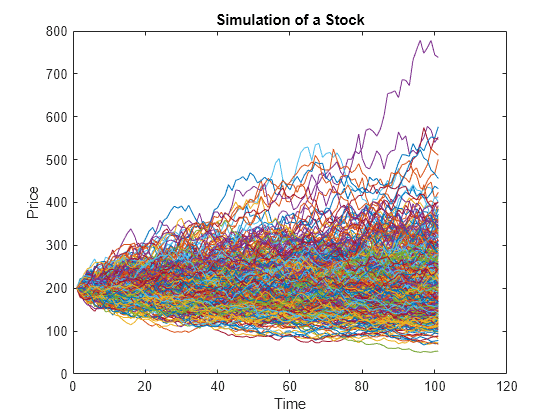
Calculate Put Option for Stock Using Black-Scholes
Use blsprice to calculate the put option.
Strike = 190; [~,Put] = blsprice(Price_0,Strike,RiskFreeRate,T,Vol);
Generate Simulation Matrix
The simulation uses two strategies: (1) stock only and (2) stock with put cover.
AssetScenarios = zeros(NTRIALS,2);
Price_T = squeeze(Paths(end,1,:));
% Strategy 1: Stock only
AssetScenarios(:,1) = (Price_T - Price_0) ./ Price_0AssetScenarios = 100000×2
0.5927 0
-0.4069 0
-0.2526 0
0.3365 0
-0.3606 0
0.5549 0
-0.2211 0
0.3080 0
0.0849 0
-0.0416 0
0.1977 0
-0.1537 0
-0.1338 0
0.1681 0
-0.3236 0
⋮
% Strategy 2: Stock with put option cover AssetScenarios(:, 2) = (max(Price_T, Strike) - (Price_0 + Put)) ./ ... (Price_0 + Put)
AssetScenarios = 100000×2
0.5927 0.4266
-0.4069 -0.1490
-0.2526 -0.1490
0.3365 0.1972
-0.3606 -0.1490
0.5549 0.3928
-0.2211 -0.1490
0.3080 0.1716
0.0849 -0.0282
-0.0416 -0.1415
0.1977 0.0728
-0.1537 -0.1490
-0.1338 -0.1490
0.1681 0.0463
-0.3236 -0.1490
⋮
Plot Distributions
The returns for the two strategies are not normally distributed.
% Create histogram figure; subplot(2,1,1); histogram(AssetScenarios(:,1),'Normalization','probability') subplot(2,1,2); histogram(AssetScenarios(:,2),'Normalization','probability')
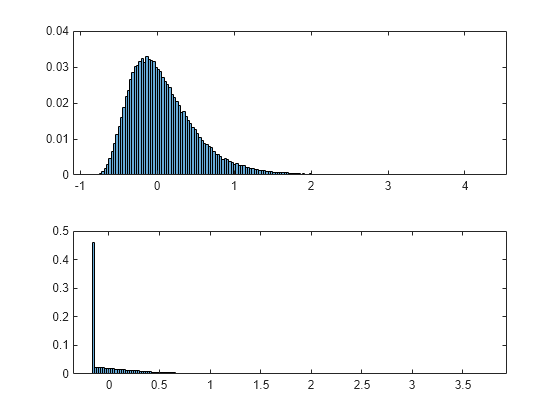
% Create scatter plot of the two strategies. Notice that the two strategies are highly % correlated. figure; scatter(AssetScenarios(1:1000,1),AssetScenarios(1:1000,2));
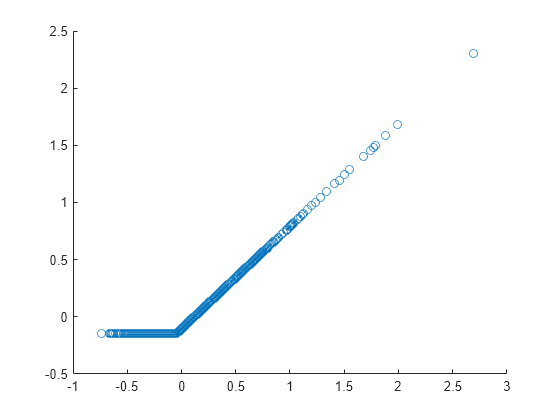
Create PortfolioCVaR Object to Obtain Portfolio Weights
Create a PortfolioCVaR object.
p = PortfolioCVaR('Scenarios',AssetScenarios,'LowerBound',0, ... 'Budget',1,'ProbabilityLevel',0.95)
p =
PortfolioCVaR with properties:
BuyCost: []
SellCost: []
RiskFreeRate: []
ProbabilityLevel: 0.9500
Turnover: []
BuyTurnover: []
SellTurnover: []
NumScenarios: 100000
Name: []
NumAssets: 2
AssetList: []
InitPort: []
AInequality: []
bInequality: []
AEquality: []
bEquality: []
LowerBound: [2×1 double]
UpperBound: []
LowerBudget: 1
UpperBudget: 1
GroupMatrix: []
LowerGroup: []
UpperGroup: []
GroupA: []
GroupB: []
LowerRatio: []
UpperRatio: []
MinNumAssets: []
MaxNumAssets: []
ConditionalBudgetThreshold: []
ConditionalUpperBudget: []
BoundType: []
% Estimate the efficient frontier to obtain portfolio weights. pwgt = estimateFrontier(p); % Plot the efficient frontier. figure; plotFrontier(p,pwgt);
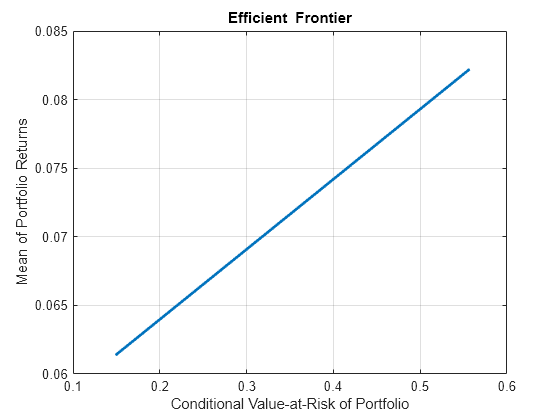
% Plot the portfolio weights. figure; area(pwgt'); axis([1 10 0 1]) legend('Stock only','Put cover'); title('Mean-CVaR Portfolio Weights');
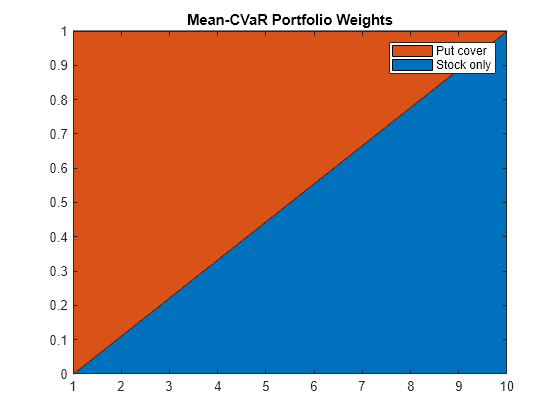
Add Hedging Strategies
Use blsprice to calculate prices of put options with different strikes.
% Put option with strike at 50% of current underlying price Strike50 = 0.50*Price_0; [~, Put50] = blsprice(Price_0,Strike50,RiskFreeRate,T,Vol); % Put option with strike at 75% of current underlying price Strike75 = 0.75*Price_0; [~, Put75] = blsprice(Price_0,Strike75,RiskFreeRate,T,Vol); % Put option with strike at 90% of current underlying price Strike90 = 0.90*Price_0; [~, Put90] = blsprice(Price_0,Strike90,RiskFreeRate,T,Vol); % Put option with strike at 95% of current underlying price Strike95 = 0.95*Price_0; % Same as strike [~, Put95] = blsprice(Price_0,Strike95,RiskFreeRate,T,Vol);
Generate Simulation Matrix for Strategies
Generate simulation matrix for the strategy variations.
AssetScenarios = zeros(NTRIALS, 5); % Strategy 1: Stock only AssetScenarios(:, 1) = (Price_T - Price_0) ./ Price_0; % Strategy 2: Put option cover at 50% AssetScenarios(:, 2) = (max(Price_T, Strike50) - (Price_0 + Put50)) ./ ... (Price_0 + Put50); % Strategy 2: Put option cover at 75% AssetScenarios(:, 3) = (max(Price_T, Strike75) - (Price_0 + Put75)) ./ ... (Price_0 + Put75); % Strategy 2: Put option cover at 90% AssetScenarios(:, 4) = (max(Price_T, Strike90) - (Price_0 + Put90)) ./ ... (Price_0 + Put90); % Strategy 2: Put option cover at 95% AssetScenarios(:, 5) = (max(Price_T, Strike95) - (Price_0 + Put95)) ./ ... (Price_0 + Put95);
Create PortfolioCVar Object Using Hedging Strategies
Create a PortfolioCVaR object using the hedging strategies.
p = PortfolioCVaR('Name','CVaR Portfolio Five Hedging Levels', ... 'AssetList',{'Stock','Hedge50','Hedge75','Hedge90','Hedge95'}, ... 'Scenarios',AssetScenarios,'LowerBound',0, ... 'Budget',1,'ProbabilityLevel',0.95); % Estimate the efficient frontier to obtain portfolio weights. pwgt = estimateFrontier(p); % Plot the efficient frontier. figure; plotFrontier(p,pwgt);
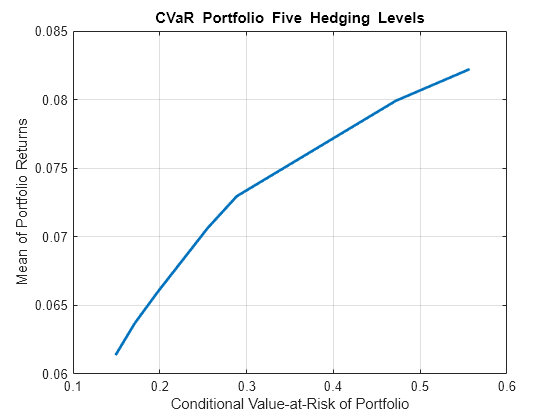
% Plot the portfolio weights. figure; area(pwgt'); legend(p.AssetList); axis([1 10 0 1]) title('CVaR Portfolio Weights');
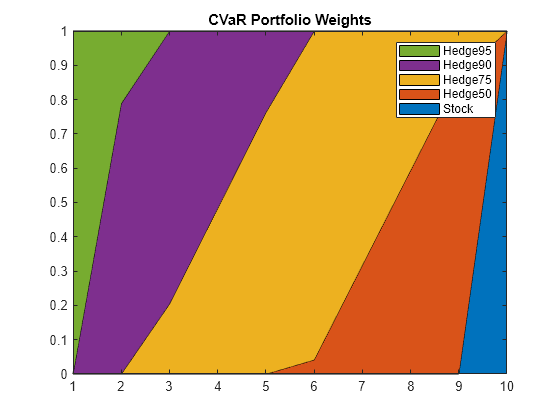
Create Mean-Variance Portfolio
Create a Portfolio object to compare with the PortfolioCVaR object.
% Create the Portfolio object. pmv = Portfolio('Name','Mean-Variance Portfolio Five Hedging Levels', ... 'AssetList',{'Stock','Hedge50','Hedge75','Hedge90','Hedge95'}); pmv = pmv.estimateAssetMoments(p.getScenarios); pmv = pmv.setDefaultConstraints; % Estimate the efficient frontier to obtain portfolio weights. pwgtmv = pmv.estimateFrontier; % Plot the efficient frontier. figure; mvFrontierHandle = pmv.plotFrontier(pwgtmv);
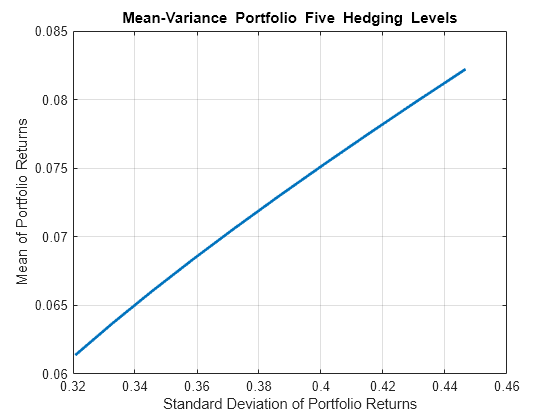
% Plot the portfolio weights. figure; area(pwgtmv'); legend(pmv.AssetList); axis([1 10 0 1]) title('Mean-Variance Portfolio Weights');
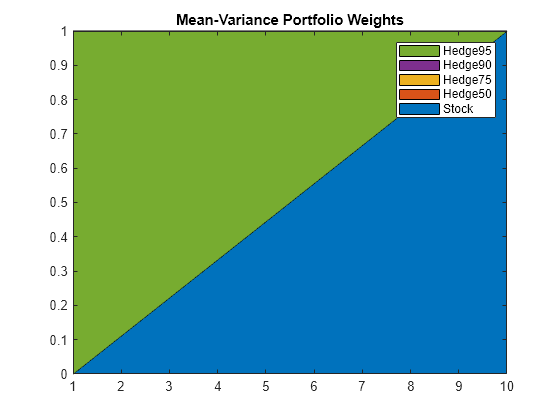
Plot Target Portfolio on Mean Variance Frontier
Determine the achievable levels of return.
% Achievable levels of return pretlimits = pmv.estimatePortReturn(pmv.estimateFrontierLimits); TargetRet = mean(pretlimits); % Target half way up the frontier % Obtain risk level at target return pwgtmvTarget = pmv.estimateFrontierByReturn(TargetRet); priskTarget = pmv.estimatePortRisk(pwgtmvTarget); % Plot point onto mean variance frontier figure; pmv.plotFrontier(pwgtmv); hold on scatter(priskTarget,TargetRet); hold off
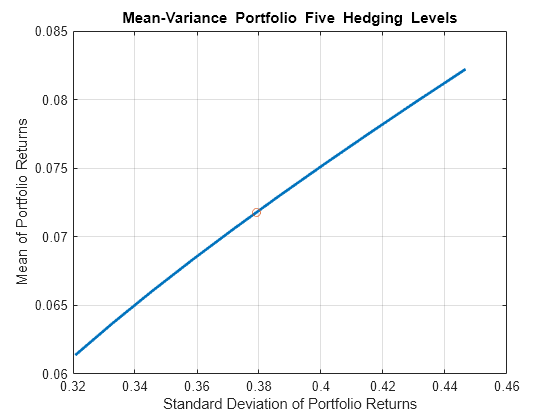
Plot Mean Variance Efficient Portfolio on CVaR Frontier
The following plot displays that the target portfolio is below the mean-CVaR efficient frontier.
% Obtain CVaR risk for mean variance target return portfolio pretTargetCVaR = p.estimatePortReturn(pwgtmvTarget); % Should be TargetRet priskTargetCVaR = p.estimatePortRisk(pwgtmvTarget); % Risk proxy is CVaR % Plot target return portfolio onto mean-CVaR frontier figure; p.plotFrontier(pwgt); hold on scatter(priskTargetCVaR,pretTargetCVaR); hold off

See Also
Topics
- Using Extreme Value Theory and Copulas to Evaluate Market Risk (Econometrics Toolbox)